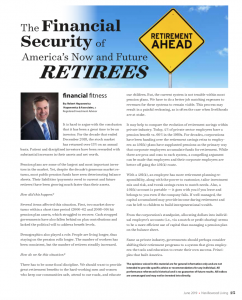The Financial Security of America’s Now and Future Retirees
This article appeared in the June 2019 edition of Nevillewood Living.
It is hard to argue with the conclusion that it has been a great time to be an investor. For the decade that ended December 2018, the stock market has returned over 13% on an annual basis. Patient and disciplined investors have been rewarded with substantial increases in their assets and net worth.
Pension plans are some of the largest and most important investors in the market. Yet, despite the decade’s generous market returns, most public pension funds have seen deteriorating balance sheets. Their liabilities (payments owed to current and future retirees) have been growing much faster than their assets.
How did this happen?
Several items affected this situation. First, two market downturns within a short time period (2000-02 and 2008-09) hit pension plan assets, which struggled to recover. Cash strapped governments have also fallen behind on plan contributions and lacked the political will to address benefit levels.
Demographics also played a role. People are living longer, thus staying on the pension rolls longer. The number of workers has been consistent, but the number of retirees steadily increased.
How do we fix this situation?
There has to be some fiscal discipline. We should want to provide great retirement benefits to the hard-working men and women who keep our communities safe, attend to our roads, and educate our children. But, the current system is not tenable within most pension plans. We have to do a better job matching expenses to revenues for these systems to remain viable. This process may result in a painful reckoning, as is often the case when livelihoods are at stake.
It may help to compare the evolution of retirement savings within private industry. Today, 4% of private sector employees have a pension benefit vs. 60% in the 1980s. For decades, corporations have been handing over the retirement savings reins to employees as 401(k) plans have supplanted pensions as the primary way that corporate employees accumulate funds for retirement. While there are pros and cons to each system, a compelling argument can be made that employees and their corporate employers are better off going the 401(k) route.
With a 401(k), an employee has more retirement planning responsibility, along with the power to customize, tailor investment mix and risk, and tweak savings rates to match needs. Also, a 401(k) account is portable – it goes with you if you leave and belongs to you even if the company fails. If well managed, the capital accumulated may provide income during retirement and can be left to children to build intergenerational wealth.
From the corporation’s standpoint, allocating dollars into individual employee’s accounts (i.e., via a match or profit sharing) seems to be a more efficient use of capital than managing a pension plan on the balance sheet.
Same as private industry, governments should perhaps consider shifting their retirement programs to a system that gives employees the tools and education to create their own success. Principles that built America.
The opinions voiced in this material are for general information only and are not intended to provide specific advice or recommendations for any individual. All performance referenced is historical and is no guarantee of future results. All indices are unmanaged and may not be invested into directly.





